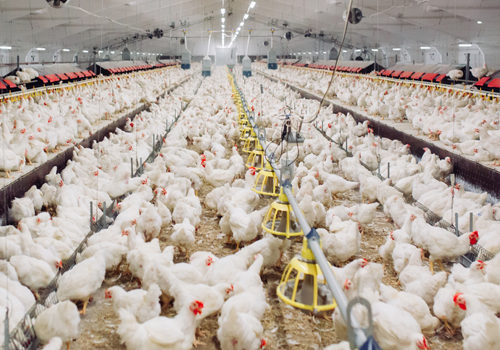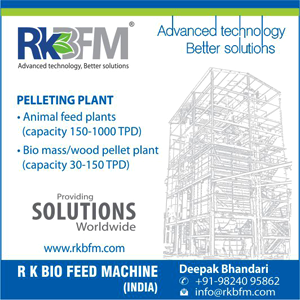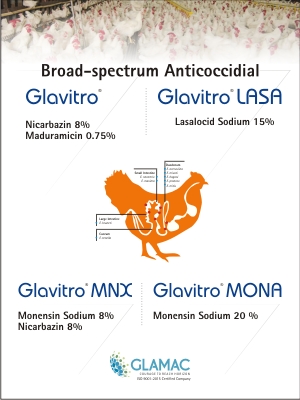Introduction: Calcium (Ca) and phosphorus (P) are essential macro-minerals in broiler nutrition, playing a crucial role in skeletal development, metabolic functions, and overall growth performance. These minerals must be supplied in the right balance to maximize feed efficiency, ensure strong bone formation, and prevent metabolic disorders. In India, where poultry farming is a rapidly growing sector, optimizing Ca and P nutrition is vital to improving bird health and farm profitability. The availability of mineral sources, variability in ingredient digestibility, and reliance on plant-based feeds necessitate precise supplementation strategies, including the use of phytase enzymes to enhance phosphorus bioavailability.

Premium Chick Feed Pvt Ltd
This article explores the latest advances in Ca and P nutrition for broilers, highlighting their impact on growth, feed formulation, and sustainability in the Indian poultry industry.
Role of Calcium and Phosphorus in Broilers:
Bone Development and Strength: About 99% of calcium and 80% of phosphorus in a broiler’s body are stored in the skeleton. These minerals are indispensable for forming strong, healthy bones that can support rapid growth and high meat yield.
Metabolic Functions: Calcium plays a role in nerve transmission, muscle contraction, and blood clotting. Phosphorus is vital for energy metabolism (ATP production), cellular function, and DNA/RNA synthesis (E. Humer et al., 2015).
Enzymatic and Hormonal Interactions: Vitamin D3 regulates calcium and phosphorus absorption, while an imbalance of these minerals can hinder enzymatic processes critical to digestion and growth (Markus Rodehutscord et al., 2022).

Kemin Industries South Asia Pvt Ltd
Sources of Calcium and Phosphorus:
Common feed ingredients providing these minerals include :
- Calcium: Limestone, dicalcium phosphate (DCP), monocalcium phosphate (MCP), meat and bone meal (MBM), and fish meal.
- Phosphorus: DCP, MCP, MBM, and plant-based sources (phytate phosphorus).
Calcium and Phosphorus Recommendations for Broilers:
Based on life stages, broilers require varying levels of these minerals. Breeding companies come out with the standard levels of these and revise the specs from time to time. Of late, there has been a lower requirement of both these minerals, apart from the early stages. In the table below, Cobb and Ross standards for the same are illustrated. Nutritionist in India follow the levels based on their experience, which are these levels or slightly tweaked levels.
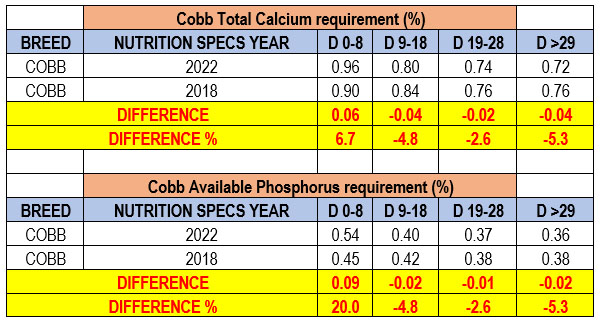
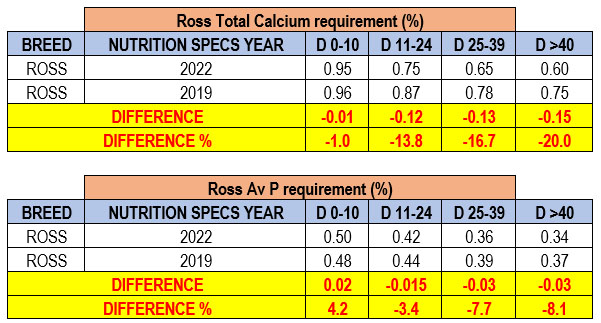
(Values taken from Cobb broiler performance and nutrition supplement 2022, available on Cobb vantress website and Ross broiler specification 2019 and 2022, available on Aviagen website)
The Importance of Balance: Total Calcium (Ca) to Available Phosphorus (P) Ratio:
The interplay between calcium and phosphorus is so strong that excess or deficiency in one mineral directly impacts the other’s utilization. The recommended dietary ratio of Ca to P typically ranges from 1.5:1 to 2:1 for broilers (Rafael F. Sens et al., 2021). An imbalance can cause the following issues:
- Excess Calcium: Reduces phosphorus absorption, lowers feed efficiency, and impairs the digestibility of other nutrients like fats and proteins (Markus Rodehutscord et al., 2022).
- Excess Phosphorus: This leads to poor bone mineralization and hinders calcium retention (Laura Shiromi David et al., 2023).
Calcium, Phosphorus, and Vitamin D3 Synergy:
Vitamin D3 is a key player in the absorption of both calcium and phosphorus. A deficiency in vitamin D3 reduces calcium and phosphorus uptake, resulting in bone disorders like rickets and poor growth performance. The inverse relationship between vitamin D3 levels and mineral requirements means that higher vitamin D3 in the diet can allow for slightly reduced levels of calcium and phosphorus.
Dietary supplementation of 25-(OH)2-D3 has a positive impact on performance, tibia ash, and serum concentration of Ca, P. This supplementation can also spare some available P in the diet, even in diets containing phytase (with Ca, available P, and sodium matrix). In many cases, the P P-sparing effect of 25-(OH)2-D3 is without any apparent change in tibia morphology. At 250 mg/kg 1,25(OH)2-D3 can spare almost 0.1% available P, which is equivalent to 6kg Di-Calcium Phosphate (DCP) per ton of feed.
Vitamin D and its metabolites 25-(OH)-D3 and 1,25-(OH)2 -D3 have numerous functions in the avian system, though the maximum attention is given to Ca and P metabolism, bone health, and eggshell structures of broilers and layers. Plant sources of vitamin D cannot be relied upon to cater to the full needs of birds. Technically, 1,25-(OH)2-D3 supplementation to diet should be more effective than 25-(OH)-D3 in alleviating negative effects associated with Ca and P imbalance and dietary vitamin D deficiency. In broilers 1,25-(OH)2 -D3 can help lower down/potentiate Av P. Weak chicks from the young hatch and management-challenged chicks can benefit more from this supplementation.
Phytate Phosphorus neutralization and Phytase matrix consideration:
A large portion of phosphorus in plant-based feed ingredients (e.g., corn, soybean meal) is bound as phytate, which is poorly digestible by broilers. In Indian poultry diets based on vegetable ingredients, up to 70% of P is present as phytate-P, bound to the phytic acid molecule and unavailable for digestion and absorption. Regular levels of phytate in corn- and soybean meal (SBM)-based diets range from 2.5 to 4.0 g/kg and can cause a negative impact on growth performance and feed efficiency, as phytate can form complexes with protein, amino acids, and also other minerals (Rafael F. Sens et al., 2021).
Analyzing the phytate levels in diets is very important while formulating. Rice polish, Deoiled Rice Bran(DORB), Cottonseed extract, Rapeseed meal, Wheat bran, and Sunflower meal have high phytates. Maize gluten meal, Ground nut extract, and Soymeal also have moderate levels of phytates. Generally, the phytate levels in broiler diets range around 0.18-0.30% and layer diets 0.30-0.50%. When formulating with alternate ingredients, the overall phytate level in the diet increases, and this impact on other essential nutrients and, ultimately, performance needs to be minimized by the addition of a good phytase at a higher dose.
Phytases are commonly used to hydrolyze phytate into free myo-inositol and 6 molecules of inorganic phosphate. Phytate degradation and elimination from the gastrointestinal tract with the use of phytase is correlated to significant improvements in P and Ca digestibility, ash content in tibia bone, weight gain (WG), and feed efficiency (J. I. M. Fernandes et al., 2019) and the extent to which phytate is eliminated from the tract can be intensified with greater levels of phytase.
The precise application of phytase matrix requires analyzing values of the phytate content of feed raw materials actually in use. It’s suggested to avoid applying the P matrix more than 90% of phytate levels in diets.
Phytase effects on the digestibility of amino acids and minerals other than P are inconsistent in the literature (Lagos et al. 2023). Expertise based on experience and a holistic approach with other enzyme matrices can help to take a call. The digestibility and requirements of antagonistic feed constituents, such as Ca, must be better elucidated to avoid excessive inclusion in the feed. The matrix value applied for any given dose of phytase is specific for the phytase source and is related to a combination of factors including differences in stability during the pelleting process and gastrointestinal tract, as well as differences in the efficiency of the phytase in degrading Inositol hexakisphosphate (InsP6) and each lower ester under the conditions of the gastrointestinal tract.
High Calcium Levels and its hidden cost:
Excess dietary calcium binds with phytates, reducing phosphorus bioavailability and protein digestibility.
We have a problem with excess calcium. This excess calcium in the diet comes through
- Ingredient adulteration (soya and other ingredients adulterated with Limestone powder (LSP)
- Water in Indian farms generally has a higher Total Dissolved Solids (TDS) and Ca between 100-200 mg/L
- Additives have LSP as a carrier
- Adulteration of some ingredients with soil
- LSP, being the cheapest ingredient at times, is used as filler in premix and full feed
Overloading broiler diets with calcium might seem like a good idea, but it can have undesirable effects in several ways. Some of the hidden costs of over calcium in diets are as follows.
- Lower Feed Intake and Growth: Too much calcium can depress feed consumption, slowing down growth rates.
- Compromised Gut Health: During stressful months, acidifiers are often added to feed to control gut pathogens. However, excess calcium raises gut pH, undermining the acidifiers’ effectiveness (Laura Shiromi David et al., 2023).
- Reduced Fat Absorption: Calcium interacts with dietary fats, forming indigestible “soaps” that hinder fat absorption.
- Impaired Protein Digestion: Calcium binds to proteins in the lower gastrointestinal tract, leading to undigested residues in droppings.
- Mineral Imbalances: High calcium levels disrupt the absorption of other critical minerals like phosphorus, magnesium, manganese, and zinc, forcing nutritionists to adjust premix levels. Excess Ca in the diet depresses P digestibility, +0.1% Ca levels decrease P digestibility by 4% (J. I. M. Fernandes et al., 2019).
Formulating diets with digestible calcium and digestible phosphorus specs:
Currently, we formulate based on total calcium and available phosphorus and aim to formulate on digestible levels in the coming years. Formulating broiler diets with optimal digestible calcium and phosphorus levels is theoretically essential for maximizing performance and profitability. However, it requires overcoming challenges that are being faced globally as well as in the Indian subcontinent.
Variability in ingredient digestibility:
Ingredients such as dicalcium phosphate (DCP), monocalcium phosphate (MCP), and limestone often vary in their mineral content and digestibility due to differences in processing, source, and quality. For example:
- The phosphorus digestibility in DCP may range from 85–90%, depending on the source.
- Limestone solubility varies with particle size and purity, impacting calcium digestibility.
- A significant portion of phosphorus in plant-based ingredients (e.g., corn and soybean meal) is bound as phytate, making it indigestible without phytase supplementation. Variability in phytate content complicates accurate formulation.
Lack of Accurate Digestibility Data (published and real-time): Many feed ingredients lack standardized published data on digestible calcium and phosphorus levels. Nutritionists often will have to rely on generalized values or outdated information, leading to inaccuracies in formulations. For the same ingredient, there is a huge variation in published digestible calcium and phosphorus levels.
Limestone Solubility and its implications:
Limestone is one of the most common sources of calcium in broiler diets, widely valued for its availability and cost-effectiveness. However, the solubility of limestone can significantly impact its nutritional efficiency and the overall health and performance of broilers.
Solubility and Particle Size: Limestone solubility is influenced by its particle size. Fine particles dissolve more rapidly in the gut, releasing calcium faster, while larger particles dissolve slowly, providing a sustained calcium supply. Solubility at times depends on the source/ore of limestone also. In India, the use of fine limestone is more but coarse grind limestone needs to be preferred more.
Fine Limestone: Highly soluble, suitable for early calcium needs.
Coarse Limestone: Less soluble, ideal for sustaining calcium levels over time.
Role of Acid Binding Capacity: Fine-grinded limestone has a high acid-binding capacity, meaning it can neutralize stomach acidity. This property can sometimes interfere with the gut’s natural digestion process, particularly for other nutrients like protein and phosphorus.
Key Takeaways:
- Calcium and phosphorus are foundational to broiler health, especially for skeletal growth and metabolic processes. Adjusting calcium and phosphorus levels based on life stage and environmental factors ensures optimal bird performance. Maintaining the correct Ca: P ratio is crucial to avoiding nutrient imbalances and maximizing performance.
- Indian diets are typically rich in calcium. While it might seem beneficial to add extra calcium to broiler diets, doing so can have several negative consequences.
- Supplementation of Vitamin D and its metabolites 25-(OH)-D3 and 1,25-(OH)2 -D3 have numerous functions in avian systems, though the maximum attention is given to Ca and P metabolism, bone health, and eggshell structures of broilers and layers.
- Supplementation of a good phytase can overcome challenges associated with phytate phosphorus in plant-based diets. The precise application of phytase matrix requires analyzing values of the phytate content of feed raw materials actually in use.
- Solubility and particle size of limestone can significantly impact its nutritional efficiency and the overall health and performance of broilers.
- Global data on digestible phosphorus and calcium is not standardized. There is a need to generate data for Indian ingredients.
- Lameness in broilers and layers should be thoroughly investigated and then action needs to be taken. Supplementing more calcium doesn’t work in 99% of cases of lameness.
- By paying close attention to these critical minerals, poultry nutritionists can unlock the full potential of broiler diets, boosting growth, feed efficiency, and profitability.
Conclusion:
Optimizing calcium and phosphorus nutrition is key to improving broiler performance, skeletal integrity, and feed utilization. As Indian poultry producers and nutritionists transition towards more efficient feeding strategies, it is crucial to adopt precise mineral balancing, utilize digestible Ca and P values, and incorporate phytase enzymes to enhance phosphorus absorption. Over-supplementation of calcium can lead to hidden costs, including impaired nutrient digestibility and poor gut health. Furthermore, understanding the solubility and particle size of calcium sources like limestone can significantly improve mineral utilization. With continuous research and innovation, the Indian poultry sector can refine its approach to these important mineral nutrition, leading to better productivity, economic efficiency, and environmental sustainability.
Authors: Dr. Vinod Koskewar and Dr. Sushant Labh.
References: - Cobb broiler performance and nutrition supplement 2018 and 2022, available on https://www.cobbgenetics.com/ - Fernandes, J.I.M., Horn, D., Ronconi, E.J., Buzim, R., Lima, F.K. and Pazdiora, D.A., 2019. Effects of phytase superdosing on digestibility and bone integrity of broilers. Journal of Applied Poultry Research, 28(2), pp.390-398. - Humer, E., Schwarz, C. and Schedle, K., 2015. Phytate in pig and poultry nutrition. Journal of animal physiology and animal nutrition, 99(4), pp.605-625. - Lagos, L. V., Choudhury, R., Castejón, C. R., Lu, H., & Stein, H. H. 2023. Amino acid and mineral digestibility, bone ash, and plasma inositol is increased by including microbial phytase in diets for growing pigs. Journal of Animal Science and Biotechnology, 14, 53. - Laura Shiromi David, M. Naveed Anwar, M. Reza Abdollahi, Michael R. Bedford and Velmurugu Ravindran. 2023. Calcium Nutrition of Broilers: Current Perspectives and Challenges. Animals 2023, 13(10), 1590. - Markus Rodehutscord, Vera Sommerfeld, Imke Kühn and Michael R. Bedford. 2022. Phytases: Potential and Limits of Phytate Destruction in the Digestive Tract of Pigs and Poultry. Enzymes in Farm Animal Nutrition, 3rd Edition CAB International. 124-153. - Rafael F. Sens et al., 2021. Effect of different doses of phytase and protein content of soybean meal on growth performance, nutrient digestibility, and bone characteristics of broilers Poultry Science 100:100917 - Ross broiler specification 2019 & 2022, available on https://aviagen.com/ .



